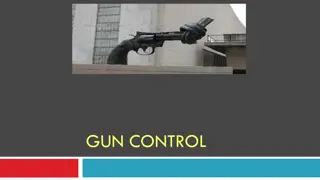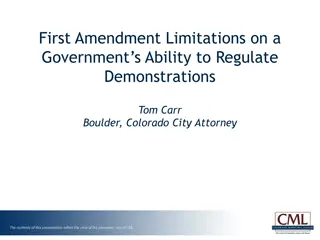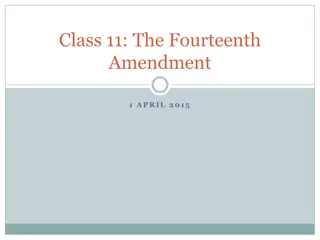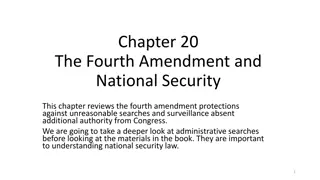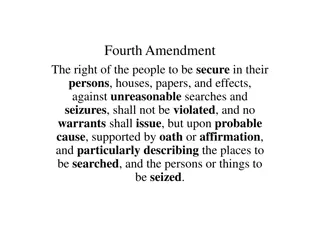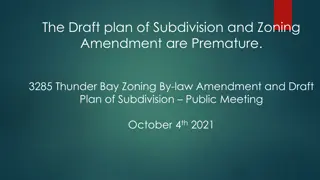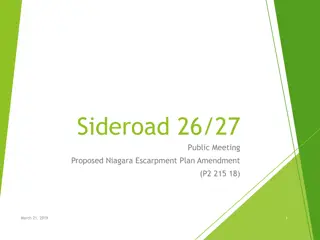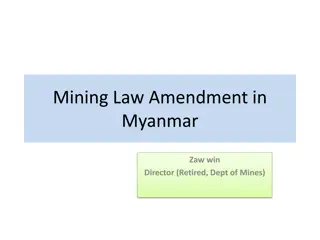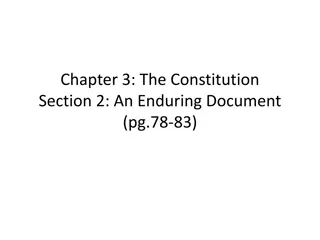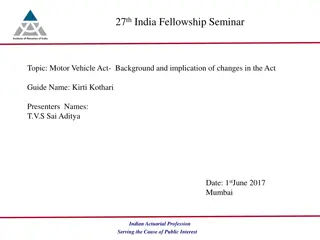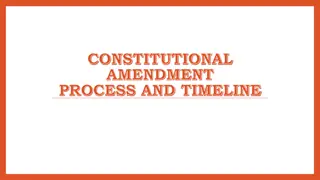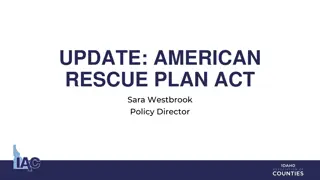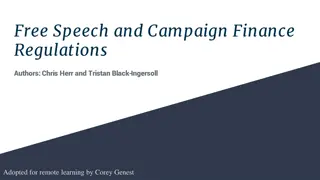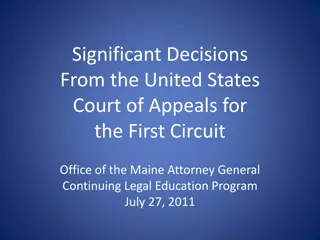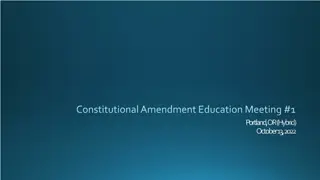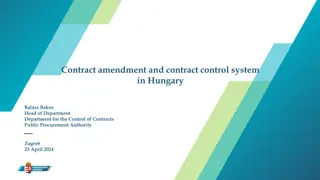Navigating First Amendment Challenges in Education
This presentation at the 2024 Wisconsin State Education Convention delves into complex First Amendment issues, focusing on employee speech, religion, student dress codes, and more. Through hypothetical scenarios, attendees will engage in discussions to find practical solutions beyond legal compliance.
Download Presentation

Please find below an Image/Link to download the presentation.
The content on the website is provided AS IS for your information and personal use only. It may not be sold, licensed, or shared on other websites without obtaining consent from the author.If you encounter any issues during the download, it is possible that the publisher has removed the file from their server.
You are allowed to download the files provided on this website for personal or commercial use, subject to the condition that they are used lawfully. All files are the property of their respective owners.
The content on the website is provided AS IS for your information and personal use only. It may not be sold, licensed, or shared on other websites without obtaining consent from the author.
E N D
Presentation Transcript
2024 Wisconsin State Education Convention Prayers by Coaches & Guns on T-Shirts: Tackling First Amendment Issues BRIAN P. GOODMAN| JANUARY 17, 2024
This presentation will take a practical approach to solving legally complex situations involving the First Amendment. This session will be driven by a series of hypotheticals designed to foster an active discussion among attendees. The goal of the presentation is to go beyond the legally compliant answer and figure out how to implement practices and solve the problems created by First Amendment issues.
Prayers by Coaches & Guns on T-Shirts: Recent First Amendment Developments Overview 1. First Amendment rights of employees with respect to speech and religion. 2. Districts right to control the curriculum. 3. Districts right to regulate classroom displays and employee dress. 4. First Amendment challenges with student dress codes. 5. Social media challenges for employees and students.
Employee Speech and Free Exercise of Religion
The First Amendment Congress shall make no law respecting an establishment of religion, or prohibiting the free exercise thereof; or abridging the freedom of speech, or of the press; or the right of the people peaceably to assemble, and to petition the Government for a redress of grievances.
First Amendment, cont. Speech made pursuant to an employee s ordinary official duties is unprotected. Garcetti v. Ceballos, 547 U.S. 410 (2006). Speech which is not on a matter of public concern is unprotected. Connick v. Meyers, 461 U.S. 138 (1983). Speech that is merely of personal concern to an individual employee is not protected. Speech which is as a citizen on a matter of public concern is protected, but only if the employee s First Amendment speech rights outweigh the district s interest as an employer. Pickering v. Bd. of Educ., 391 U.S. 563 (1968). This is called the Pickering Balancing Test.
First Amendment, cont. Factors that a court in the Seventh Circuit will consider when applying this balancing test include: Whether the speech would create problems in maintaining discipline or harmony among co-workers; Whether the employment relationship is one in which personal loyalty and confidence are necessary; Whether the speech impeded the employee s ability to perform his or her responsibilities; The time, place, and manner of the speech; The context in which the underlying dispute arose; and Whether the matter was one on which debate was vital to informed decision-making.
Kennedy v. Bremerton School District The facts in this case are disputed between the majority decision and the dissent, but these are the facts as framed narrowly in the majority opinion. A public high school football coach briefly engaged in personal prayer on the football field immediately following the games. The U.S. Supreme Court held that he was not engaged in speech ordinarily within the scope of his duties as a coach when he was praying. He was not speaking pursuant to a government policy and was not seeking to convey a government-created message. His prayers did not owe their existence to his responsibilities as a public employee. Additionally, other coaches were free to attend briefly to personal matters, and students were engaged in other activities at the time of his prayers.
Kennedy v. Bremerton School District, con t. This case also had an impact on case law on the First Amendment s Establishment Clause ( Congress shall make no law respecting an establishment of religion ) The Court used this case to explicitly overrule the three-part Lemon test for establishing whether a governmental action violated the Establishment Clause, and subsequent case law that further developed a test known as the Endorsement Test which asks whether in the totality of the circumstances a reasonable observer would perceive the governmental action as a religious endorsement. In place of those tests, the Establishment Clause must be interpreted by reference to historical practices and understandings, and that the line that governments draw between permissible and impermissible endorsement of religion has to accord with history and faithfully reflect the understanding of the Founding Fathers. Given the uncertainty and rapidly shifting legal landscape surrounding the Establishment Clause, districts should be cautious before asserting that any given action constitutes a violation of the Establishment Clause.
Kennedy v. Bremerton School District, con t. Takeaways from the case: The U.S. Supreme Court is trending toward increased protections for the free exercise of religion. If other employees are free to perform personal tasks at a given time, it is likely that a court would hold that such employees can use that time for private personal prayer. In general, the current U.S. Supreme Court is hesitant to impute an individual s religious actions and expression to school districts which limits the legal risk of the district violating the Establishment Clause. An employee is not necessarily acting in the course of their ordinary official duties for First Amendment purposes at all times while they are on school property. Courts will look at the totality of the circumstances, including whether an employee is on a formal or informal break at the time of the expressive activity. Coercing students to engage in religious practices/prayer with an employee is likely still impermissible. This decision did not turn on coercion. For example, there is still controlling U.S. Supreme Court case law that prohibits prayer at graduation and prayer over the loudspeakers at football games based on student coercion concerns.
Hypothetical #1 In-between class periods, a teacher says a brief quiet prayer at their desk. The teacher does not have hallway duty, but kids come and go from the teacher s room. A parent complains about this activity. Can the district force the teacher to stop praying between classes in the classroom?
Curriculum, Dress Codes, and Classroom Displays
Curriculum and the First Amendment School boards have the right to control the curriculum in their schools and require teachers to follow that curriculum, including by requiring neutrality on controversial issues by teachers while teaching. Many districts have also adopted policies with respect to teaching controversial subjects. This can generally include a requirement that teachers teach both sides of certain controversial topics. Similarly, school boards can select a specific curriculum. The concept of Academic Freedom does not apply in the context of K-12 instruction.
Employee Dress Codes and Displays Districts can generally enforce reasonable employee dress codes, including prohibitions on displaying political or controversial images on their clothing, on jewelry, or on accessories, while employees are performing their duties. However, employees have the right to request reasonable accommodations to the code for religious beliefs, which should be granted so long as the accommodation does not impose a hardship on the district. Districts can also generally regulate classroom displays that are part of the curriculum or that will be viewed by students during instructional time, provided the district has not allowed parts of the classroom (such as the teacher s desk) to become a limited public forum for individual expression through the district s past practice, including past acquiescence to such expression. Districts must enforce these policies consistently and be aware of the potential that protected concerted activity issues might arise in certain instances involving dress codes and classroom displays.
Hypothetical #2 A district passes a policy that prohibits employees from using the walls of their classrooms for personal expression. All wall displays must relate to the curriculum. The district enforces this constituently policy for the walls, but doesn t regulate teachers desks. A teacher places a small LGBTQ+ pride flag on their desk. Can the district require the teacher to remove the flag from their desk? Can the district modify its display policy to apply to teachers desks as well? If the policy is changed, can the district require the teacher to remove the flag? What if other teachers have small personal displays on their desks, like sports team flags, cartoons, photos, and other knickknacks that arguably constitute the teacher s personal expression; can the district still require the teacher to remove the pride flag?
Student First Amendment Rights The First Amendment does not protect the following on-campus student speech: Speech within the context of school-sponsored and controlled curriculum, such as the contents of a student newspaper prepared by a journalism class; Speech that can reasonably be viewed as promoting illegal drug use; Speech that is a true threat; and Speech that is obscene, vulgar, lewd, indecent, or plainly offensive. School officials can restrict protected student speech if they can forecast that the expressive activity will materially interfere with or substantially disrupt a school activity, or if the expression intrudes on the rights of other students. Tinker v. Des Moines Indep. Cmty. Sch. Dist., 393 U.S. 503 (1969).
Be Happy Not Gay The Seventh Circuit Court of Appeals held in 2011 that a student could wear a T-shirt sporting that statement at school on the Day of Silence (an activity in support of homosexual rights). A particular form of harassment or intimidation can be regulated only if the speech at issue gives rise to a well-founded fear of disruption or interference with the rights of others. School authorities are entitled to exercise discretion in determining when student speech crosses the line between hurt feelings and substantial disruption of the educational mission, because they have the relevant knowledge of and responsibility for the consequences. By contrast, Homosexuals Go To Hell has been held to be fighting words subject to regulation.
Gun T-Shirt Bans Schoenecker v. Koopman, 349 F. Supp. 3d 745 (E.D. Wis. 2018) Preliminary injunction granted to a student who sought to prohibit the school from disciplining him for wearing t-shirts that depict weapons. Applying Tinker, the judge in this case held that the school district did not show that it had a reasonable belief that the student s shirts would cause a threat of substantial disruption. As part of a settlement, the district agreed not to restrict wearing shirts with guns or weapons if they don t advocate or imply violent or illegal use of guns. N.J. v. Sonnabend, (7th Circuit June 15, 2022) The Neenah School District and the Kettle Moraine School District were sued by students seeking permanent injunctions prohibiting administrators from enforcing dress code prohibitions on clothing depicting firearms. (The dress code didn t expressly prohibit firearms, but rather, the administration interpreted inappropriate attire to bar any clothing that depicted guns). The Seventh Circuit Court of Appeals rejected the district court s analysis which had held that Tinker did not apply to viewpoint neutral dress code regulations, such as this regulation which was viewpoint neutral because it applied to images of guns that were both pro-gun and anti-gun. The Seventh Circuit Court of Appeals remanded the case back to the district court to apply Tinker to this situation. The court held that no observer would construe the message on the students clothing as being school-sponsored or school-endorsed, which meant the viewpoint neutral test was not the proper test to apply. According to the court, in applying Tinker, school officials can take into account the age of the students that will receive the message, the history of the school and student body, and temporal factors such as recent events.
Pointers in Analyzing and Responding to Student Speech Focus on the specific facts. Is the student expressing a particularized message (through words, actions, or symbols)? Focus on the current environment in the district to help prove a substantial disruption is a reasonable likelihood. Discipline v. teachable moments.
Hypothetical #3 A high school student wears a custom-made T-shirt that depicts their favorite video game. The image on the shirt is of a first-person shooter game, so the gun being used by the player is prominent. The shirt depicts zombies that have been head shotted. The zombies are wearing the uniform of the rival high school basketball team. Can the district prohibit the student from wearing the shirt? What if the student only wears the shirt at the upcoming home basketball game against the rival?
Social Media and the First Amendment
First Amendment and Employee Social Media Districts may discipline employees for off-duty social media use when a connection exists between the district s interest and the employee s social media use, and the employee s social media use is not protected by the First Amendment. For example, a district generally couldn t discipline an employee for liking a mildly controversial social media page. However, a district would likely be able to discipline an employee who makes a Facebook post that threatens to cause specific physical harm to a co- worker.
Hypothetical #4 A high school vice principal posts on social media a scathing critique of the way discipline is handled by the District Administrator of the district where the vice principal works (which also happens to be the district his children attend). Specifically, the vice principal calls the District Administrator stupid and states that it is dangerous that the District Administrator doesn t recommend expulsions until age 21 for all students caught fighting at school. (Not coincidentally, there was a significant fight at his children s middle school, but his children weren t involved). At the bottom of his post, the vice principal states that this message is only his personal opinion, and not that of the school. Can the district take disciplinary action against the vice principal?
B.L. v. Mahanoy Area School District A cheerleader (B.L.) that failed to make the varsity team took a Snapchat picture in which she used a swear word to describe her feelings about cheerleading and the cheerleading program at her school and sent it to her 250 Snapchat friends. Another student took a screenshot of the snap and showed it to a cheerleading coach and other members of the cheerleading squad. The district suspended her from the JV cheerleading team for the upcoming school year.
B.L. v. Mahanoy Area School District, con t. In a narrow ruling, the U.S. Supreme Court held that the district s discipline of B.L. was a violation of the student s First Amendment rights. However, the Court left the door open for school officials to regulate off-campus speech in other situations. The Court found that at its core, B.L. s speech was critical of the team, the coaches, and the community. However, the First Amendment generally provides strong protection to this type of pure speech. The Court emphasized that at the time of the speech, B.L. was off campus, using her personal device, and messaging her private circle of Snapchat friends. She was not wearing any clothing bearing the school s name, and she did not reference the school or any individual by name in her speech.
B.L. v. Mahanoy Area School District, con t. The Court expressly stated that in certain circumstances, schools might be able to regulate off- campus speech. These circumstances might include: Serious or severe bullying or harassment targeting particular individuals; Threats aimed at teachers or other students; The failure to follow rules concerning lessons, the writing of papers, the use of computers, or participation in other online school activities; and Breaches of school security devices, including material maintained within school computers.
Hypothetical #5 While at home, a student threatens, via a Snapchat to a large group of classmates, to jump another student at the public library tomorrow. A concerned classmate takes a screenshot of the snap and shares it with the principal. Can the district discipline the student for this post? If not, what can the district do? What if the student threatens to jump the other student at school the next day instead of at the library?
Athletic/Extracurricular Codes of Conduct Districts may wish to review their athletic/extracurricular codes of conduct in light of the B.L. decision. Districts can still enforce the code against student misconduct that isn t First Amendment protected speech. For example, if a student posted a picture of himself drinking a beer at a weekend party, that isn t protected speech because it isn t attempting to express a particular idea. However, codes that broadly prohibit inappropriate or vulgar postings on social media might need to be reevaluated in light of the case. B.L. s speech might be considered inappropriate or vulgar, but the Court still found it to be protected by the First Amendment. In some cases, the words of the code might not need to be revised, but rather those responsible for administering the code need to understand that the code must be administered consistently with the First Amendment rights of students.
Student Anti-Discrimination Districts have a legal obligation to provide an educational environment free of harassment based on a legally protected class to students. The U.S. Supreme Court stated that severe harassment of an individual through off-campus social media is a possible justification for districts to regulate off-campus social media posts by students. Districts should ensure that the off-campus social media that constitutes potential harassment does not create a potentially hostile educational environment for the student based on a legally protected class. Federal laws: Title IX, Section 504, Title VI enforced by the federal Department of Education, Office for Civil Rights ( OCR ). State laws: Wis. Stat. Sec. 118.13; PI 9 enforced by the state Department of Public Instruction ( DPI ). These laws protect students from harassment and discrimination in school programs based on specific protected classes such as: sex, race, religion, national origin, ancestry, creed, pregnancy, marital or parental status, sexual orientation, or disability.
Student Bullying The U.S. Supreme Court also stated that severe bullying of an individual through off-campus social media is a possible justification for districts to regulate off- campus social media posts by students. Under Wis. Stat. Sec. 118.46, school boards must adopt a policy prohibiting bullying by pupils. Districts should review these policies with respect to off- campus social media. Many bullying policies are already limited to school and school-sponsored functions and events. Some policies also discuss cyberbullying, but that concept must be understood within the limited scope of the bullying policy (school and school-sponsored functions and events). Districts will need to evaluate on a case-by-case basis whether off-campus social media posts by students might be actionable under their bullying policies. Additionally, districts will need to evaluate whether the specific posts at issue are sufficiently severe as to permit districts to enforce its bullying policy consistent with the limitations placed on districts under the First Amendment.
Hypothetical #5 A freshman member of the hockey team is subjected to vicious bullying by members of the hockey team through a Snapchat group that is not run by the district (but is comprised solely of the student members of the hockey team, including the freshman student). Some of the texts also contain racial slurs referring to the freshman student. Can the district discipline the students engaged in the bullying/harassment? Does it matter if some of these Snaps were sent while the hockey team was traveling to a game?
Applying Mahanoy to Bullying The family of a student who was bullied filed a bullying complaint with the student s high school administration alleging that he was being bullied by the student s hockey team. After an investigation, the district suspended multiple students for bullying, including for bullying by using Snapchat while off-campus. Two students sued the district arguing that the district s action violated their First Amendment rights. They argued that the Snapchat messages were private and not subject to regulation by the school. The court emphasized the importance of giving school administrators deference so long as their judgment was reasonable. The school reasonably determined that the students (1) caused emotional harm to the bullied student, (2) created a hostile environment for the bullied student during school-sponsored events and activities, and (3) infringed on the bullied student s rights at school. The court cited to B.L. v. Mahanoy as support for the idea that a school s regulatory interests remained significant in off-campus circumstances of serious or severe bullying targeting particular individuals. Additionally, the students who engaged in the bullying were not solely engaged in off-campus bullying. Some of the bullying took place at school and at school activities. The court also explained that the general statement of discontent by the student in Mahanoy was vastly different from the speech in this case which was serious bullying that targeted a specific student. Doe v. Hopkinton Public Schools (1stCircuit Court of Appeals).
Questions? Brian P. Goodman, Attorney, Boardman Clark bgoodman@boardmanclark.com 608-283-1722
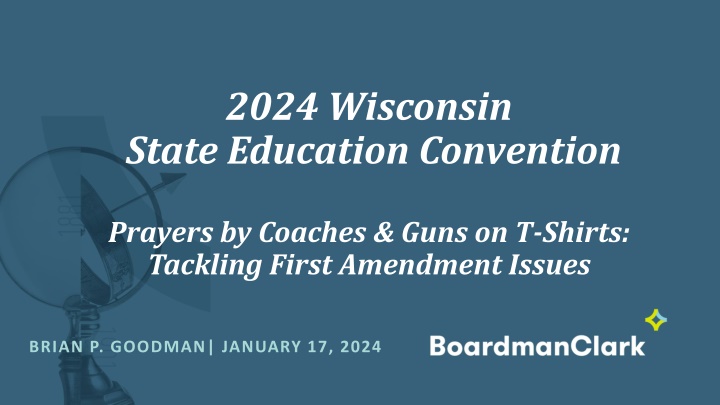

![RE: ELECTORAL MATTERS AMENDMENT BILL [ B42-2023]](/thumb/18837/re-electoral-matters-amendment-bill-b42-2023.jpg)


